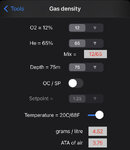So, for the 15°C factor, I computed the density using the formula pV=nRT. Since p is constant, the volume is proportional to the temperature (in Kelvin, that is 15°C=388K, 0°C=373K), and the density is inversely proportional to it. Therefore, it is sufficient to divide the density by a factor =373/388.
Anyway, it doesn't matter what temperature you use for the calculation since the reference is the air at 30m. The important thing is that you compare densities relative to the same temperature.
So it's ok to use 5.2308, but you need to compare it with other densities calculated at the same temperature (0°C). I believe that the 5.2 that @Heat Miser mentioned comes exactly from here (nx32 density at 0°C and 30m deep), and nx32 is always higher than the other GUE CCR standard gases at their MOD (see my table). This is why I believe that @Heat Miser made a mistake, but maybe I am missing something or I myself made some mistakes in my calculation.
OC gases are a bit different; I did the calculation during the tec1, but I don't really remember it (shame on me!), and I am too lazy to do it again now
EDIT: I modified the post, you calculated it at 0°C, not at 20°C... at higher degree, the densities are even lower (compare it with my table)
I put the temperature because I wanted to give the details of the figure I computed.
Just realised MultiDeco can compute gas density.
On my phone, for EAN32:
- 4.84 at 20C
- 5.20 at 0C
They use 4.02 ATA at 30m




